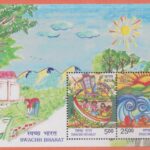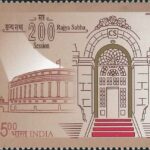
Bharat – The Mother of Democracy
Complete set of 3 nos. of postage stamps on Bharat – The Mother of Democracy (world’s oldest and largest democracy, India) :



 Issued by India
Issued by India
Issued on Jan 25, 2024
Issued for : Department of Posts is delighted to release a miniature sheet of 3 commemorative postage stamps on Bharat – The Mother of Democracy and salutes the democratic spirit of world’s largest democracy.
Credits :
Miniature Sheet/FDC/Brochure/Cancellation Cachet : Sh. Suresh Kumar
Type : Miniature Sheet, Mint Condition
Colour : Multi Colour
Denomination : 500 Paise (3)
Miniature Sheets Printed : 143334
Printing Process : Wet Offset
Printer : Security Printing Press, Hyderabad
About :
- A 31 gun salute to the President heralded the birth of Indian Republic shortly before 1030 hours on January 26, 1950. It was 894 days after the country attained the dominion status following the end of British rule. The ceremony was held in the brilliantly decorated Darbar Hall of the Government House (now Rashtrapati Bhawan) and was attended by about 500 prominent dignitaries including Dr Soekarno, the President of Indonesian Republic. It was the beginning of a new Republic based on the principles of justice, liberty, equality and unity.
- This (26th January 2024) being the 75th Republic Day inspires us to look back and realize that Bharat has been the beckon of Democracy long before this idea was rediscovered by western thinkers. It is no surprise that after independence, the people of this country took to democracy as duck takes to water.
- India had a history of Republics that existed before and after Buddha. One such republic was Lichchhavi which was a part of Vajjika territory and contemporary village of Basarh in Vaishali district of Bihar. The references of Lichchhavi are in Pali, Tibetan, Jain, Greek, Nepalese, and Chinese and Sanskrit texts. Universal Civil rights, franchise, general assembly, rule of law, deliberation and procedures of committees and appeals are the democratic features, which were well established in Lichchhavi Gana-Rajya. Lichchhavis had an open and secret ballot system; their presidents (ganapati), Vice presidents (up ganapati), army chiefs (senapati), ambassadors and other key heads of administration-judiciary were elected through consensus and electoral contests, if required.
- It was one of the earliest document reference to democracy and hence can be called mother of democracy in the recorded history of mankind. It operated on the principal that ‘let one faulty escape than to punish one who is not guilty’. It was a role model for Buddha. His Sangh was founded on the functioning style of this Lichchhavi gana-rajya.
- Sangam literature and epigraphical sources throw valuable information on the socio-economic condition of Tamil Nadu. In the Chola period, the Uttiramerur inscription of C. 919 and 921 CE of the Chola king, Parantaka I, laid down the rules for the election of persons to the several committees which administered the village. It mentions the nagaram, which denotes both the town of the merchants and their assembly, the ur or village assembly and the urar (members of the village assembly). The different local bodies coexisted peacefully. The leader of the mahasabha/sabha was an elected representative. It highlights an early form of decentralized governance in the region.
- Uttiramerur inscription describes a meticulous electing process for members of the Sabha. It involved a lottery system, ensuring fairness. The eligibility criteria included age, property ownership and moral conduct. The Sabha served as a committee responsible for various administrative functions, including resolving disputes, maintaining law & order and overseeing local affairs. Major decisions were taken through discussions and consensus-building. For accountability, the inscription mentions provisions for impeaching and removing individuals from the sabha if found guilty of misconduct or corruption.
- Sikhism, founded by Guru Nanak in the 15th century, embodies several democratic ideals that promote equality, justice and community participation. It emphasizes the equality of all individuals, irrespective of caste, creed, gender or social status. The concept of ‘Ik Onkar’ (One supreme reality) underscores the oneness of humanity and rejects any form of discrimination.
- The Sikh tradition encourages active participation of its followers in community affairs. The Institution of langar (community kitchen) exemplifies Sikh democratic values, promoting social equality and community solidarity. The Sikh prayer ‘Sarbat da Bhala’ translates to ‘May everyone be blessed’ promotes an inclusive and compassionate society. The Gurmata system involves reaching consensus through discussion and agreement among community members.
- When Bharat is entering into Amrit Kaal, it is opportune time to reclaim the legacy of our forefather and great thinkers who sowed the seed of Democracy in our DNA. Bharat was, is and will remain forever the Mother of Democracy.
- Text : Referenced from content provided by Proponent.
Subscribe
Login
0 Comments
Oldest







